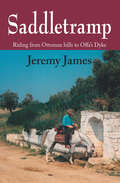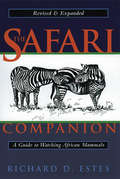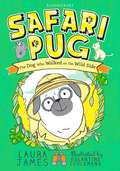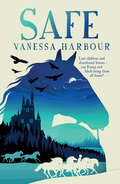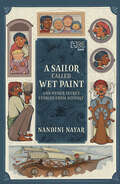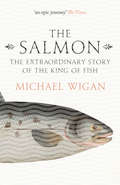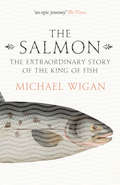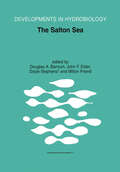- Table View
- List View
Saddle Club Book 9: Saddle Club Bindup 5 (The\saddle Club Bindup Ser. #Bk. 5)
by Bonnie BryantLisa’s love of horses has grown over the past few months. As a member of the Saddle Club, she feels it’s her duty to spread the word about all the good things happening at Pine Hollow Stables. But when her new column, Hoof Beat, starts running weekly in the local paper, Lisa’s not getting the happy reaction she expected. Is there a difference between telling the facts, and reporting the news?
Saddle Club Super: Western Star
by Bonnie BryantCarole, Stevie and Lisa – the girls of The Saddle Club – are heading west to spend the first part of their Christmas holidays at the Bar None Ranch. But when a winter storm keeps them from returning home to Willow Creek for the holiday celebrations, the girls are heartbroken.Then an almost miraculous series of events touches each member of The Saddle Club and reminds them that there are more important things than presents and time off from school.Join The Saddle Club on an unforgettable trip that recalls the true spirit of giving and the strength of friendship.
Saddle Club Super: Dream Horse
by Bonnie BryantStevie Lake gets conked on the head so hard she’s laid up in hospital. Then she starts having weird dreams about herself and her Saddle Club friends, Carole Hanson and Lisa Atwood. No big deal – until the dreams start coming true! First it’s just little things. Stevie saw Phil get thrown off Teddy before it happened. She knew Starlight was going to stomp on Carole’s foot. Then Carole and Lisa rely on one of Stevie’s dreams to make a dream of their own come true.But when their sick friend has a scary vision, the girls aren’t sure they want to know: It is just a horse in Stevie’s dreams, or is it a nightmare!
Saddle Club Super: Nightmare
by Bonnie BryantWhen a fatal equine virus breaks out at a nearby stable, The Saddle Club has to endure forty-five days of waiting and worrying about whether the disease will reach Pine Hollow. Then Carole realizes that one of her favorite horses may already be infected, and she decides to take matters into her own hands and hide the horse. Can Carole protect Pine Hollow? Or will she discover that there is nothing she can do to keep her worst nightmare from becoming reality?
Saddle Club Super: The Secret Of The Stallion (Saddle Club Super Edition Ser. #No. 2)
by Bonnie BryantIt’s going to be one of the most amazing adventures The Saddle Club has ever had! Stevie, Lisa and Carole are going to horsey England. They’ll even ride in a show on the grounds of a real castle.Then Lisa discovers an ancient, unsolved mystery about the duke who once lived in the castle. The duke buried treasure under the stall of his spirited stallion. Tragedy struck – the barn burned down and the stallion perished. A year later, the duke’s body was found in the same spot, his hands clutching a single fire opal. Legend says the treasure will be found by a rider with fire in his heart…Join The Saddle Club as they try to uncover the secret of the stallion.
Saddle Club Super 1: A Summer Without Horses
by Bonnie BryantWhen Stevie Lake injures herself and can’t ride for a while, the other two members of The Saddle Club, Carole Hanson and Lisa Atwood, make a pact of friendship not to ride until Stevie has recovered. To seal the pact, they decide that if the vow is broken by any of them, they’ll have to ask stuck-up Veronica diAngelo to join their club. That will keep them out of the saddle for sure.But can three horse-crazy girls really stay away from horses and riding for more than a day? Find out in this first Saddle Club Super Edition, which contains three separate stories about Lisa, Stevie and Carole – and their summer without horses!
Saddletramp: Riding from Ottoman Hills to Offa's Dyke
by Jeremy JamesIn the depths of winter, Jeremy James began a horseback ride from central Turkey to his hometown in Wales, a journey which was to take him eight and a half months. First he had to find his horse, an unlikely old and weary Arab stallion who eventually rose to the challenge with equal spirit to that of his new master. With uncertain mastery of their route, the two of them crossed rivers and mountains to reach the Greek border. Here their close bond had to break and Jeremy was forced to buy Maria, an unbroken filly who he then rode to the Italian border and changed her for Gonzo, who took him on the idyllic stretch through Umbria and Tuscany. Crossing the Alps together, they rode through late-summer France to reach their destination, Wales, in November. Jeremy writes with humour and sensitivity about the people and places this journey takes him, but it is his bond with his horses that makes the thread which binds the narrative and infuses the whole adventure.
The Safari Companion: A Guide to Watching African Mammals Including Hoofed Mammals, Carnivores, and Primates
by Richard D. Estes Daniel Otte Kathryn S. FullerSince its original publication in 1993, The Safari Companion has been the best field guide to observing and understanding the behavior of African mammals. An indispensable tool for naturalists traveling to Africa, this new edition has been revised to acknowledge the enthusiasm to those watching these magnificent animals at zoos and wildlife parks, and on film. The Safari Companion enables readers to recognize and interpret visible behavioral activities, such as courtship rituals, territorial marking, aggression, and care of young. Each account of over 80 species includes a behavioral table in which the unique actions of the hoofed mammals, carnivores, and primates are described for easy reference. In addition, useful maps show the major national boundaries, vegetation zones, and game parks relevant to the guide. The book includes an extensive glossary, as well as tips on wildlife photography, a list of organizations working to protect African wildlife, and advice on where and when to see the animals.
Safari Pug (The Adventures of Pug #3)
by Laura James Églantine CeulemansMeet the brilliant, the wonderful, the courageous ... Safari Pug! The third book in a joyful illustrated series for fans of Claude and Squishy McFluff.When Pug and Lady Miranda have a scary run-in with a lion one night (it might be hiding under the bed), Lady M decides Pug needs to face his fears and go on safari. Pug goes a bit wobbly when he finds out he'll be coming nose to nose with Florence, the rare white lion cub, but he soon realises that lions may not be the most dangerous thing in the wildlife park ...
Safe
by Vanessa HarbourIn the chaotic last days of World War II, Jacob and Kizzy are tricked into a life or death journey. Far from home, they are attacked and only just escape. They hide in a seemingly deserted mansion, but they keep hearing strange noises... Investigating, they find it shelters not only forty abandoned horses but a small band of lost children, displaced by the war. With danger on every side, can Kizzy and Jakob keep them safe and get them all home?
Safe Handling and Restraint of Animals: A Comprehensive Guide
by Stella J. ChapmanProvides all you need to know about the safe and humane handling and restraint of animals. Safe Handling and Restraint of Animals takes a holistic approach to the handling of a wide variety of animal species. This comprehensive resource offers a thorough overview of how to safely handle and restrain a number of commonly encountered species including dogs, cats, small mammals, exotic pets, horses and farm animals. Each chapter discusses the behaviour of the species and then outlines the appropriate handling and restraint methods, including any equipment required, multiple explanatory photographs, and useful further reading. Covers a wide range of species commonly encountered by veterinary staff and those working within animal industries Includes key points and self-assessment questions at the end of each chapter, and a glossary of terms Ideal for students of any animal-related degree or diploma programme, including veterinary medicine, veterinary nursing, and animal studies and husbandry Written for students and professionals who work with animals, Safe Handling and Restraint of Animals: A Comprehensive Guide encompasses all aspects of handling and physical restraint, including biosecurity and welfare issues.
Safe Handling and Restraint of Animals: A Comprehensive Guide
by Stella J. ChapmanProvides all you need to know about the safe and humane handling and restraint of animals. Safe Handling and Restraint of Animals takes a holistic approach to the handling of a wide variety of animal species. This comprehensive resource offers a thorough overview of how to safely handle and restrain a number of commonly encountered species including dogs, cats, small mammals, exotic pets, horses and farm animals. Each chapter discusses the behaviour of the species and then outlines the appropriate handling and restraint methods, including any equipment required, multiple explanatory photographs, and useful further reading. Covers a wide range of species commonly encountered by veterinary staff and those working within animal industries Includes key points and self-assessment questions at the end of each chapter, and a glossary of terms Ideal for students of any animal-related degree or diploma programme, including veterinary medicine, veterinary nursing, and animal studies and husbandry Written for students and professionals who work with animals, Safe Handling and Restraint of Animals: A Comprehensive Guide encompasses all aspects of handling and physical restraint, including biosecurity and welfare issues.
Safety in Cell and Tissue Culture
by G. Stacey Alan Doyle P. HambletonIt is now more than half a century since animal cells first came into regular use in the laboratory. Instances of laboratory acquired infection and con tamination of therapeutic products, derived from the use of animal cell cultures are rare. The use of animal cells, in addition to an established role in the production of vaccines and therapeutic proteins, has many new medical applications including gene therapy, tissue engineering and cell therapy. Furthermore, C;ldvances in molecular and cell biology are enabling rapid development and application of these technologies and the development of new and more sensitive methods, such as nucleic acid amplification, for the characterisation of cells and the detection of adven titious agents. However, it is clear that there is no room for complacency in this field and the recent expansion in the use of animal cells in the manufacture of medical products and the development of new biological assays for diagnostic and pharmaco-toxicological screening, underlines the need for vigilance regarding the correct and safe use of animal cells as substrates. This book is therefore very timely and should prove to be a highly valuable text, finding a wider audience beyond those with respon sibility for laboratory safety. The book guides the reader from fundamental cell biology issues and the establishment of new in vitro methods, through testing and validation of cell lines and on to issues in the use of animal cells in manufacturing processes.
Safety of Meat and Processed Meat (Food Microbiology and Food Safety)
by Fidel ToldráSafety of Meat and Processed Meat provides the reader with the recent developments in the safety of meat and processed meat, from the abattoir along the processing chain to the final product. To achieve this goal, the editor uses five approaches. The first part deals with the main biological contaminants like pathogen microorganisms, specially E. coli and L. monocytogenes, toxins and biogenic amines that can be present either in meat or its derived products. The second part focuses on main technologies for meat decontamination as well as developments like active packaging or bioprotective cultures to extend the shelf life. The third part presents non-biological contaminants and residues in meat and meat products including nitrosamines, PAH, veterinary drugs and environmental compounds. The fourth part discusses current methodologies for the detection of microorganisms, its toxins, veterinary drugs, environmental contaminants and GMOs, and the final part deals with predictive models, risk assessment, regulations on meat safety, consumer perception, and other recent trends in the field. This book is written by distinguished international contributors with excellent experience and reputation. In addition, brings together advances in different safety approaches.
Sailing Across a Wounded Sea
by Giuseppe Notarbartolo di SciaraThe capacity of humans to destroy their environment is playing out like a Greek tragedy in the Mediterranean Sea. After having coexisted with a diversity of marine animals throughout their history, humans have broken the balance in recent decades, and the survival of countless marine creatures is now increasingly uncertain. However, unlike in classical tragedies, real-life entities are not necessarily doomed by their fate, and there must be hope to turn the tide in nature’s favour. Lack of concrete conservation action might be simply due to a lack of awareness: how can we feel sad about a loss if we don’t know what we are losing? “Sailing Across a Wounded Sea” is the story of an ideal journey around the Mediterranean to meet its non-human inhabitants, consisting of real episodes collected over half a century as the author observed real animals, exchanged views with a variety of contacts, and argued for such views in the policy arena. Encountering whales, dolphins,seals and rays in their habitat and on their terms will hopefully contribute to building up in readers a collective commitment to help secure a future for these species. A future where they are allowed to flourish as they were meant to - had humans never trod so heavily on the sea’s delicate ecological balance and the interwoven natural processes. Giuseppe Notarbartolo di Sciara has been involved for a lifetime in protecting marine biodiversity in various capacities – as a scientist, civil servant, advocate and sailor. Having studied in California and worked with whales, dolphins and sharks worldwide, he returned to the Mediterranean in 1985, keen on using his acquired tools to discover more about the ancient sea's natural history. Here, he described small but vibrant populations of fin and sperm whales, along with various species of dolphins, manta rays and the monk seal. At the same time, seeing the Mediterranean’s progressive degradation at the hands of humans, he felt a surge of rebellion against this squandering of natural values, and wished to raise awareness of the existence of these marine natural treasures and the risk of losing them. “Drawing from decades of first-hand experiences, in ‘Sailing Across a Wounded Sea’ Giuseppe Notarbartolo di Sciara offers a compelling narrative that interweaves the beauty of the Mediterranean Sea’s non-human inhabitants with the challenges they face due to human activity. As he reflects on his journey, the author underscores the imperative for collective action and the need for heightened awareness and proactive conservation measures to protect our oceans. ‘Sailing Across a Wounded Sea’ serves not only as a captivating voyage but also as a sobering call to responsibility. Join Giuseppe Notarbartolo di Sciara on this insightful expedition and discover the profound significance of preserving our marine ecosystems for future generations.” —Peter Thomson, United Nations Secretary General’s Special Envoy for the Ocean “The Mediterranean, the cradle of civilisation, is a sea steeped in history. From Apollon and Artemis to Pythagoras and Hercules, names in this book summon up images of civilisations past and lost. The greatest Greek philosopher of them all, Aristotle, is also regarded as the father of marine biodiversity, stemming from his research conducted on Lesbos Island. And yet this ancient world, familiar to so many, is under threat. In this book Notarbartolo di Sciara takes us on a modern-day odyssey through these waters, based on over 50 years of personal observations. He reminds us of the impact of the progressive footprint of human action and endeavour, which has spread out across the whole sea, changing, and depleting its beauty and splendour. His voyage paints a picture not just of what is at stake but also of the potential the future can hold if we all work together to give nature a breathing space, to allow it to restore and recover. In our modern world, where we h
A Sailor Called Wet Paint and Other Secret Stories from History
by Nandini Nayar"What can a lady in a thin sari do to survive in COLD England?How will a ship's crew RETURN home without any money?When did the young ayah last see her OWN family?And why, oh why, did the sailor write WET PAINT in a young girl's diary?Nannies and sailors taken 4,000 miles away to England to work...it's the same SORRY tale. Often ABANDONED, they have to find their own way across the sea, back home to India! It's upsetting. It's shocking. It's breaking our hearts. What are we to DO? Well, here are stories - a whole SHEAF of them about AYAHS in a foreign land and the Indian crew of LASCARS on ships, questioning why the British don't treat these people kindly. Asking to give them the home, the care and the freedom they deserve. But is ANYONE listening? Are YOU? "
Salamandastron: A Tale From Redwall (Redwall #5)
by Brian JacquesAs Redwall slumbers in the summer sun, it is unaware that the mountain stronghold of Salamandastron lies besieged by the weasel army of Ferahgo the Assassin, and that the deadly Dryditch fever is creeping towards the Abbey. But the sword of Martin the Warrior sends Samkin and Arula from Redwall over forest, swamp and great waters to try and save Salamandastron from being turned into a centre of evil power. . . . .
Saliva in Health and Disease: The Present and Future of a Unique Sample for Diagnosis
by Asta Tvarijonaviciute Silvia Martínez-Subiela Pia López-Jornet Elsa LamySaliva as a unique sample for health assessment is gaining attention among researchers of different fields in the last 20 years; being reflected in an impressive increase in the number of papers published studying saliva from different biological aspects in human and veterinary species. Once deemed merely a digestive juice is now considered a biological fluid capable of communicating information about physiopathological processes occurring in organisms, since saliva has been shown to contain molecular and bacterial compounds that can change in response to local and systemic pathologies. Furthermore, the interest of saliva as a diagnostic, prognostic and monitoring biofluid is forced by its non-invasive nature being of easy and inexpensive sampling, involving only minimal discomfort and allowing the collection of multiple/repeated specimens at anytime, anywhere and without need for specialized staff. In this contributed volume, the authors bring together, summarize and reflect the generated knowledge about saliva as a source of biomarkers for health and welfare evaluation in humans and animal models. This volume also highlights the importance of confounding factors, such as sampling methods, flow, total protein content, contamination, or storage. This book will serve as a manual for graduates, practitioners and researchers by providing general ideas about the possibilities and utilities of saliva in clinical practice or investigation, and indicating the main cautions each should have in mind before saliva usage.
Salmon: Economics and Marketing
by S. Shaw J.F. Muirwith the issues involved in the management of salmon fishing. farming and ranching and the implications for production costs and the availa bility of supplies. Chapters 6 and 7 investigate processing. marketing and distribution and Chapter 8 discusses the workings of salmon markets and the main factors affecting the demand for salmon. Finally. chapter 9 summarises the main findings of the study and considers the issues likely to define the future of the industry. The main interest of the book is in salmon sold commer cially and mention is only made in passing of the rather different. though important. issues involved in the management of sport or recreation fisheries. This book does not cover all species of salmon but concentrates on the main species of current commercial significance. These are the five commercially important species of Pacific salmon all of which belong to the single separate genus ONCORHYNCHUS together with SALMO SALAR. the Atlantic salmon. The related SALMO GAIRDNERI (rainbow trout) and SALMO TRUTTA (brown troutl seatrout) are outside the scope of the book. although since these compete closely with salmon. the relationship is discussed. 1.2 THE SALMON: LIFE CYCLE AND SPECIES The family salmonidae is indigenous to the Northern Hemisphere and is found from the temperate zone northwards to beyond the Arctic Circle. 1n both Pacific and Atlantic waters. They are not· native to the Southern Hemisphere but have been successfully introduced into New Zealand. into Argentina. Venezuela and more recently Chile and the Kerguelen Islands.
The Salmon: The Extraordinary Story Of The King Of Fish
by Michael WiganA fascinating journey into the extraordinary world of the king of fish: the salmon. This beautiful book explores the natural history of this most mysterious of fishes.
The Salmon: The Extraordinary Story Of The King Of Fish
by Michael WiganA fascinating journey into the extraordinary world of the king of fish: the salmon. This beautiful book explores the natural history of this most mysterious of fishes.
Salmonella in Domestic Animals
by Michael Jones Andrew Roycroft Muna Anjum Andreas Bäumler Frank Aarestrup Pete Kaiser H Shivaprasad Hafez Hafez Bernardo Villarreal-Ramos John Timoney Frank Pasmans Martin Wierup R La Ragione Katherine Hollinger Pia Mäkelä John Wain Filip Van Immerseel Paula Cray Malcolm Cobb Kris De Smet R DaviesSalmonella remains a major cause of economic loss in domestic livestock and human food poisoning worldwide. In the last 10 years there have been major advances in understanding the salmonella organism, meaning a compiled source of the new research is urgently needed. With fully updated chapters and new coverage of genome structure, virulence, vaccine development, molecular methods for epidemiology and exotics, this second edition is an invaluable resource for researchers of animal and human health.
Saltmarsh (British Wildlife Collection)
by Clive Chatters“Saltmarshes are often remote, inhospitable places, neither land nor sea, as hard to pin down as they are to navigate. In this saline odyssey, Clive Chatters has explored his favourite creeks, pools and mudflats to bring us an absorbing celebration of the ecology, biology, geology and history of this scarce and mysterious habitat. There are Tadpole Shrimps, and rare sedges, waders and Wild Celery – even inland saltmarshes – in this tour de force by a superb naturalist and writer.“ BRETT WESTWOOD, naturalist, author and radio presenter Saltmarshes are among Britain's most diverse and dynamic landscapes. They abound around our shores but may also be found inland and at altitude – wherever water, salt and vegetation combine. The species they support range from extreme rarities of specialised habitats to the less demanding denizens of coastal wetlands. Here is a landscape of international importance for migratory birds, endemic plants and an exceptional variety of invertebrates. Clive Chatters has a lifetime's affinity with saltmarshes. In this fifth volume of the British Wildlife Collection, he celebrates their natural history and diversity, from the highly distinctive marshes in the Scottish Highlands to the urban remnants of the Thames estuary now engulfed within the capital. By examining the past of these complex habitats, we can gain an insight into how they have developed, and an understanding of their relationship with people. In addition to their exceptionally diverse natural history, saltmarshes are sources of food and medicine, they play a pivotal role in flood defence and carbon sequestration, and have inspired artistic endeavour.
Saltmarsh (British Wildlife Collection)
by Clive Chatters“Saltmarshes are often remote, inhospitable places, neither land nor sea, as hard to pin down as they are to navigate. In this saline odyssey, Clive Chatters has explored his favourite creeks, pools and mudflats to bring us an absorbing celebration of the ecology, biology, geology and history of this scarce and mysterious habitat. There are Tadpole Shrimps, and rare sedges, waders and Wild Celery – even inland saltmarshes – in this tour de force by a superb naturalist and writer.“ BRETT WESTWOOD, naturalist, author and radio presenter Saltmarshes are among Britain's most diverse and dynamic landscapes. They abound around our shores but may also be found inland and at altitude – wherever water, salt and vegetation combine. The species they support range from extreme rarities of specialised habitats to the less demanding denizens of coastal wetlands. Here is a landscape of international importance for migratory birds, endemic plants and an exceptional variety of invertebrates. Clive Chatters has a lifetime's affinity with saltmarshes. In this fifth volume of the British Wildlife Collection, he celebrates their natural history and diversity, from the highly distinctive marshes in the Scottish Highlands to the urban remnants of the Thames estuary now engulfed within the capital. By examining the past of these complex habitats, we can gain an insight into how they have developed, and an understanding of their relationship with people. In addition to their exceptionally diverse natural history, saltmarshes are sources of food and medicine, they play a pivotal role in flood defence and carbon sequestration, and have inspired artistic endeavour.
The Salton Sea (Developments in Hydrobiology #161)
by Milton Friend Doyle Stephens John F. Elder Douglas A. BarnumFor the first time, an effort to conduct coordinated interdisciplinary research on a vast and complex saline lake has been undertaken for the purposes of providing baseline data to guide restoration project activities. This volume compiles state-of-the-art science for the Salton Sea and will serve as the foundation for the next several generations of scientific inquiry for California's largest lake. The science presented here reveals the Salton Sea to be one of the most productive fisheries in the world, details why the Salton Sea is important to migratory and wintering birds, investigates the microbial world and reports numerous taxa new to science, and documents chemical and physical interactions which make this inland saline lake function. This book is intended for specialists in saline lake research who are interested in all aspects of saline lake ecology.






